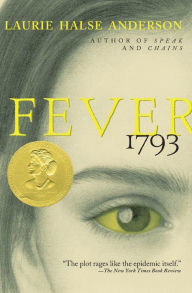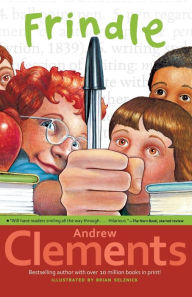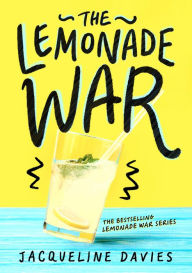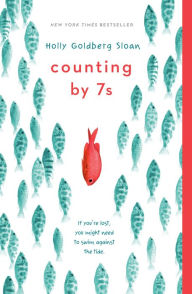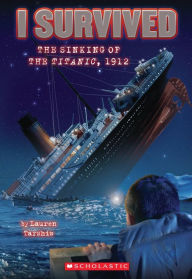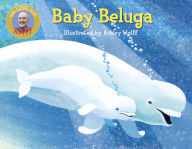An epidemic of fever sweeps through the streets of 1793 Philadelphia in this novel from Laurie Halse Anderson where "the plot rages like the epidemic itself" (The New York Times Book Review).
During the summer of 1793, Mattie Cook lives above the family coffee shop with her widowed mother and grandfather. Mattie spends her days avoiding chores and making plans to turn the family business into the finest Philadelphia has ever seen. But then the fever breaks out.
Disease sweeps the streets, destroying everything in its path and turning Mattie's world upside down. At her feverish mother's insistence, Mattie flees the city with her grandfather. But she soon discovers that the sickness is everywhere, and Mattie must learn quickly how to survive in a city turned frantic with disease.
From the Publisher
School Library Journal starred review Readers will be drawn in by the characters and will emerge with a sharp and graphic picture of another world.The New York Times Book Review A gripping story about living morally under the shadow of rampant death.
VOYA A vivid work, rich with well-drawn characters.
The New York Times Book Review The plot rages like the epidemic itself.
Publishers Weekly - Publisher's Weekly
The opening scene of Anderson's ambitious novel about the yellow fever epidemic that ravaged Philadelphia in the late 18th century shows a hint of the gallows humor and insight of her previous novel, Speak. Sixteen-year-old Matilda "Mattie" Cook awakens in the sweltering summer heat on August 16th, 1793, to her mother's command to rouse and with a mosquito buzzing in her ear. She shoos her cat from her mother's favorite quilt and thinks to herself, "I had just saved her precious quilt from disaster, but would she appreciate it? Of course not." Mattie's wit again shines through several chapters later during a visit to her wealthy neighbors' house, the Ogilvies. Having refused to let their serving girl, Eliza, coif her for the occasion, Mattie regrets it as soon as she lays eyes on the Ogilvie sisters, who wear matching bombazine gowns, curly hair piled high on their heads ("I should have let Eliza curl my hair. Dash it all"). But thereafter, Mattie's character development, as well as those of her grandfather and widowed mother, takes a back seat to the historical details of Philadelphia and environs. Extremely well researched, Anderson's novel paints a vivid picture of the seedy waterfront, the devastation the disease wreaks on a once thriving city, and the bitterness of neighbor toward neighbor as those suspected of infection are physically cast aside. However, these larger scale views take precedence over the kind of intimate scenes that Anderson crafted so masterfully in Speak. Scenes of historical significance, such as George Washington returning to Philadelphia, then the nation's capital, to signify the end of the epidemic are delivered with more impact than scenes of great personal significance to Mattie. Ages 10-14. (Sept.) Copyright 2000 Cahners Business Information.
Publishers Weekly
PW called this ambitious novel about the yellow fever epidemic that ravaged 18th-century Philadelphia "extremely well researched. However, larger scale views take precedence over the kind of intimate scenes that Anderson crafted so masterfully in Speak." Ages 10-up. (Mar.) Copyright 2001 Cahners Business Information.
VOYA
Set in Philadelphia, the nation's capital at the end of the eighteenth century, this engrossing and well-written story chronicles one young girl's experiences during the yellow fever outbreak. Fourteen-year-old Matilda Cooke works for her widowed mother in their family's coffee shop. She faces a great struggle when it becomes clear that the city is in the midst of an epidemic from which no one is invulnerable. When her mother becomes gravely ill, she forces Matty to leave the city with her grandfather to escape the risk of infection. Matty eventually contracts the illness but recovers and returns to Philadelphia in search of her mother and her former existence. Fever 1793 is a vivid work, rich with well-drawn and believable characters. Unexpected events pepper the top-flight novel that combines accurate historical detail with a spellbinding story line. Of note to history teachers, the text includes an appendix that offers additional information on both the medical and burial practices of the period as well as several events and organizations depicted in the book. Matty is a strong female protagonist faced with horrific circumstances beyond her control, and her story will appeal to both genders in grades six through twelve. The book's first-person account of the epidemic's personal side is highly recommended for all public and school libraries. Booktalk this important work, and libraries will not be able to keep copies on the shelves. Appendix. VOYA CODES: 5Q 4P M J S (Hard to imagine it being any better written; Broad general YA appeal; Middle School, defined as grades 6 to 8; Junior High, defined as grades 7 to 9; Senior High, defined as grades 10 to 12). 2000, Simon & Schuster,256p, $16. Ages 12 to 18. Reviewer: Dr. Stefani Koorey SOURCE: VOYA, December 2000 (Vol. 23, No. 5)
Children's Literature
The best historical fiction is the kind that immerses you in the time period through the mindset of a primary character. Anderson's Mattie Cook does just that. In this diary based novel, we entire the harrowing experience of a yellow fever epidemic in Philadelphia in 1793. Mattie dreams of turning the family coffeehouse into a booming business and struggles to cope with her strict mother. But those issues are pushed aside when yellow fever strikes. Then Mattie has to fight for her life and the lives of her family. The city is turned upside down. Mattie struggles through it all. Readers will applaud her heroism and learn a lot about post-Revolutionary War Philadelphia in the process. 2000, Simon and Schuster, $16.00. Ages 10 up. Reviewer: Alexandria LaFaye
KLIATT
To quote KLIATT's July 2000 review of the hardcover edition: At the beginning of August 1793, Philadelphia was the largest city in the U.S., with 40,000 residents. Up on High Street, 14-year-old Mattie helps her mother and her grandfather run her family's coffeehouse, along with a freed slave named Eliza. Then the dreaded yellow fever strikes...Mattie's coming-of-age tale, set against the backdrop of Philadelphia's terrible epidemic, succeeds in conveying both her strong-willed spirit and the difficulties of life in that era, when daily work was ceaseless and backbreaking. Mattie changes convincingly from a resentful teenager to a responsible adult over the course of a few months, as the dreadful events around her force her to grow up. Anderson, the author of the acclaimed YA novel Speak, presents an interesting and little-known episode in history here, and readers will enjoy getting to know her feisty female protagonists. Includes an appendix providing historical background on the yellow fever outbreak. An ALA Best Book for YAs and one of the New York Public Library's Best Books for the Teen Age, among other honors. Category: Paperback Fiction. KLIATT Codes: JS—Recommended for junior and senior high school students. 2000, Simon & Schuster, Aladdin, 252p., ?? Ages 13 to 18. Reviewer: Paula Rohrlick; KLIATT SOURCE: KLIATT, March 2002 (Vol. 36, No. 2)
School Library Journal
Gr 6-10-Mattie Cook, a spirited 14-year-old girl, lives with her widowed mother who manages a coffee house during the late 1700's in Philadelphia, the nation's capital. During August of 1793, the yellow fever engulfs the city. Mattie must make decisions that affect herself, Eliza, a free black widow and friend, her grandfather, and an orphaned girl, Nell. This coming of age novel by Laurie Halse Anderson (S&S, 2000) gives a full-bodied aroma to life of the markets, docks, printing houses, artists and upper class lifestyles and adds multicultural flavor with monies exchanged such as, pence from Massachusetts, shillings from Virginia, British pounds and French francs. While the book itself is exciting and informative, especially with the closing comments on the Free African Society of 1787, coffee houses of the 1790's, and synopses of yellow fever and "Moving the U.S. Capitol," the narration by actress Emily Bergl does not enrich it. The lack of variation of intensity and tone in the reader's voice makes it difficult to distinguish between narration and dialogue. Despite the range of foreign, ethnic, and varying classes of characters, the voices are not clearly distinguishable, even among the most prevelant ones. The pauses between dialogue and "she said" or "he said" cause a staccato rhythm and make this reading less than first rate.-Tina Hudak, St. Bernard's School, Riverdale, MA Copyright 2001 Cahners Business Information.
Kirkus Reviews
In an intense, well-researched tale that will resonate particularly with readers in parts of the country where the West Nile virus and other insect-borne diseases are active, Anderson (Speak, 1999, etc.) takes a Philadelphia teenager through one of the most devastating outbreaks of yellow fever in our country's history. It's 1793, and though business has never been better at the coffeehouse run by Matilda's widowed, strong-minded mother in what is then the national capital, vague rumors of disease come home to roost when the serving girl dies without warning one August night. Soon church bells are ringing ceaselessly for the dead as panicked residents, amid unrelenting heat and clouds of insects, huddle in their houses, stream out of town, or desperately submit to the conflicting dictates of doctors. Matilda and her mother both collapse, and in the ensuing confusion, they lose track of each other. Witnessing people behaving well and badly, Matilda first recovers slowly in a makeshift hospital, then joins the coffeehouse's cook, Emma, a free African-American, in tending to the poor and nursing three small, stricken children. When at long last the October frosts signal the epidemic's end, Emma and Matilda reopen the coffeehouse as partners, and Matilda's mother turns up—alive, but a trembling shadow of her former self. Like Paul Fleischman's Path of the Pale Horse (1983), which has the same setting, or Anna Myers's Graveyard Girl (1995), about a similar epidemic nearly a century later, readers will find this a gripping picture of disease's devastating effect on people, and on the social fabric itself. (Fiction. 11-13)
Read More

